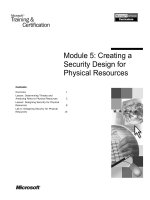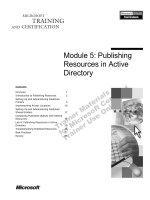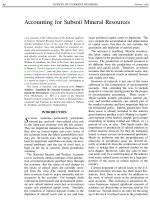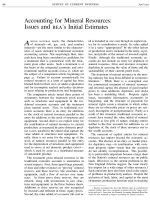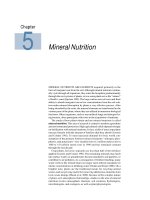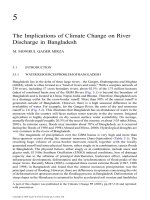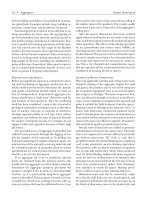Mineral resources 5
Bạn đang xem bản rút gọn của tài liệu. Xem và tải ngay bản đầy đủ của tài liệu tại đây (2.62 MB, 44 trang )
Mineral, Vitamins
& Energy
By
Dr. Hamda Qotba, B.Med.Sc, M.D, ABCM
2004
Dr. Hamda Qotba
1
Objectives
1) Demonstrate minerals source, absorption
and side effect of their deficiency
2) Illustrate vitamins function, source, and
condition related to deficiency
3) Define fibers, their effects and diseases
related to deficiency
4) Introducing energy requirements and BMR
calculation
2004
Dr. Hamda Qotba
2
Mineral elements
Account 3% body weight
Essential constituent of soft
tissue,fluid & skeleton
Calcium Phosphorus potassium
sulphur sodium chlorine iron
fluorine copper zinc iodine
cobalt manganese chromium
selenium
2004
Dr. Hamda Qotba
3
Function
1. Are constituent of bone & teeth
(calcium, phosphorus, magnesium)
2. Control the composition of body fluid
(extracellular & blood= sodium & chloride )
(intracellular = Potassium,phosphorus,
magnesium)
3. Incorporate into enzyme & protein
(sulphur is part of A.A methionine &
cysteine)
2004
Dr. Hamda Qotba
4
Calcium
Adult body contains 1-1.5kg of ca
Function
Deposit in soft tissue to harden them
Plays part in controlling heart action,
skeletal muscle & excitability of the nerve
Has role in blood clotting
Absorption
Facilitated by vit. D, proteins
Reduced by phytic acid, oxalic acid
2004
Dr. Hamda Qotba
5
Calcium
Sources
dairy product, fortified flour, egg,leafy
vegetable, fish, cabbage, broccoli
Requirement
Adult 500mg/day, Pregnancy 1200mg/day
excreted in urine and feces
Deficiency
Rickets in children & Osteomalacia in adult
2004
Dr. Hamda Qotba
6
Function
Phosphorus
Combined with calcium to form the bone & teeth
Essential cell component (phospholipid)
Maintain acid/ base balance
Release energy from carbohydrate & fat
Absorption
Assisted by formation of soluble salt
Sources
Meat, egg, dairy, fish, cereals
Deficiency
Teeth decay
2004
Dr. Hamda Qotba
7
Iron
Function
Formation of hemoglobin
Constituent of enzyme
Storage
Liver, bone marrow & spleen in the form
of ferritin
Absorption
facilitated by ascorbic acid
inhibited by phytic acid, lack of gastric
secretion
2004
Dr. Hamda Qotba
8
Iron
Sources
Meat, egg, flour, bread, leafy vegetable,
liver, kidney, dried fruits
Requirement (10-15mg/day)
To
replace loss from urine, bleeding
& menstruation
Formation of additional hemoglobin
In lactation
Deficiency
IDA
2004
Dr. Hamda Qotba
9
Iodine
Function
Formation of thyroxin
Source
vegetables, seafood
cabbage, turnip & hard water (goitrogens )
Deficiency
Endemic goiter, cretinism in children
2004
Dr. Hamda Qotba
10
Fluorine
Found in teeth & skeleton
Sources
water, tea , seafood
Function
prevent dental caries
Excessive
intake cause discoloration of the teeth
2004
Dr. Hamda Qotba
11
Sodium
Function
Plays part in the fluid exchange
between cell and tissue fluid
Source
Salt, egg, meat, fish, cheese
Excessive
Hypertension
Deficiency
Fatigue, muscle cramps
2004
Dr. Hamda Qotba
12
Potassium
Found in the body cell
It action is complement to that of
sodium
Source: fruit, veg, coffee
Kidney regulate potassium in the body
Excessive cardiac arrest
Deficiency cause muscle paralysis
2004
Dr. Hamda Qotba
13
Other minerals
Chlorine: from NaCl deficiency cause
vomiting
Magnesium: essential element, deficiency
occur in some disease
Copper: improve anemia.
Zinc: deficiency cause growth failure, poor
wound healing it occurs with parasitic
infection,malabsorption
Cobalt: B12, necessary for RBC
development
2004
Dr. Hamda Qotba
14
Water
65-70% of body weight
It is the basis of all body fluids
Function
Needed
for all chemical reactions
Maintain body temp. & lubrication
Person can live on it , die without it
Sources
Fluids
1000-2500ml
Food 1000-1500ml
Metabolic activity 200-400ml
2004
Dr. Hamda Qotba
15
Water
Balance: maintain by kidney, lost
through urination, sweating,
defecation
Dehydration: loss of water usually
happens during excessive vomiting,
diarrhea, hemorrhage, burns,
uncontrolled D.M
2004
Dr. Hamda Qotba
16
Vitamins
Organic substance which an organism must
obtain from it’s environment in minute
amount it is essential for normal metabolism
Function: they act by promoting a specific
chemical reaction in a metabolic process
Classification
fat soluble (A, D, E, K)
water soluble (B group, C)
2004
Dr. Hamda Qotba
17
Vitamin A
The chemical name of vitamin A is retinol.
The major storage site of vitamin A in the
body is in the liver.
Function
1) night vision the best known function of
vitamin A is in vision, where it participates in
the formation of retinal pigment that helps the
eye to see in dim light
2) healthy epithelial tissue this function
maintains differentiation of epithelial cells such
as skin, lung, and intestinal tissue.
3) normal development of teeth and bones.
2004
Dr. Hamda Qotba
18
Vitamin A
Sources: liver, egg yolk, fortified
foods, green leafy vegetables,
orange and red fruits and vegetables,
carrot, peach, apricot, prune, kidney,
butter, oily fish and milk.
Destroyed by cooking and exposure
to light
2004
Dr. Hamda Qotba
19
Vitamin A
Diet recommendations: For adult
human males, the Recommended
Dietary Allowance (RDA) is 750ug
Retinol for adult females, 1200ug
2004
Dr. Hamda Qotba
20
Deficiencies:
1.
2.
3.
Vitamin A
Night blindness is one of the early signs of
vitamin A deficiency, because of the role of
vitamin A in vision.
Bacterial invasion and permanent scarring of
the cornea of the eye (xerophthalmia) is a
symptom of more profound deficiency, but this
is due to a different mechanism,
the lack of vitamin A for control of gene
expression. Profound vitamin A deficiency also
results in altered appearance and function of
skin, lung, and intestinal tissues
2004
Dr. Hamda Qotba
21
VITAMIN D
Calciferol
Function to increase the efficiency of
intestinal calcium absorption and to
mobilize calcium stores from bone in
order to maintain the serum calcium and
phosphorus concentrations within the
normal physiological range.
2004
Dr. Hamda Qotba
22
Vitamin D
Formation Vitamin D3 (cholecalciferol) and
vitamin D2 (ergocalciferol) are stored in body
fat.
The vitamin D precursors produced in yeast
and plants (ergosterol) and animals
(7-dehydrocholesterol) are converted to
vitamin D by exposure to ultraviolet light.
Vitamin D (either vitamin D2 or vitamin D3) is
metabolized in the liver to 25-hydroxyvitamin D
and then to 1, 25-dihydroxyvitamin D in the
kidney. 1, 25-Dihydroxyvitamin D is considered
to be the biologically functioning form of
vitamin D.
2004
Dr. Hamda Qotba
23
Vitamin D
Food sources:
1. Non dietary by conversion inside the
body
2. Dietary Good food sources are milk
properly fortified with vitamin D, fatty fish
such as salmon and mackerel, cod liver oil,
fish liver oil, some breads and cereals, and
some egg yolks.
Not affected by storage or preservation or
cooking
2004
Dr. Hamda Qotba
24
Diet recommendations
Based on the available literature
and assuming some exposure to
sunlight, an AI for ages 0 - 50 years
was set at 200 IU (5 µg)/day. There
was no compelling data to increase
the vitamin D requirement either
during pregnancy or lactation..
2004
Dr. Hamda Qotba
25
